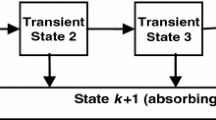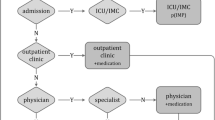Abstract
A discrete event simulation model of the patient pathways in the treatment of coronary heart disease (CHD) was used to quantify the health gains and costs associated with increasing secondary prevention drugs prescription for patients with CHD based on the level recommended in the National Service Framework for the UK. A Gompertz distribution was sampled for time to failure (death or non-fatal heart attack). The time to failure was modified in relation to the reduced risk of failure for those on the relevant drugs. The results from the model were validated against national data. Increasing the levels of prescription of secondary prevention drugs to those patients with CHD might prevent 100 deaths per million population per year and cost an additional £4 million per million population per year. With cost per life year saved of £5520, this appears good value for money compared with other health technologies.

Similar content being viewed by others
References
APTT (2002). Collaborative meta-analysis of randomised trials of antiplatelet therapy for prevention of death, myocardial infarction, and stroke in high risk patients. BMJ 324: 71–86.
Babad H et al (2002). The development of a simulation model of primary prevention strategies for coronary heart disease. Health Care Mngt Sci 5: 269–274.
Birkhead J (2003). Where are we today? Early results from MINAP, the National Audit of Myocardial Infarction Project. Heart 89(Suppl 2): ii13–ii15.
Blackburn DF et al (2005). Adherence to statins, beta-blockers and angiotensin-converting enzyme inhibitors following a first cardiovascular event: a retrospective cohort study. Can J Cardiol 21: 485–488.
Chase D et al (2006). Using simulation to estimate the cost effectiveness of improving ambulance and thrombolysis response times after myocardial infarction. Emerg Med J 23: 67–72.
Collinson J (2000). Prospective Registry of Acute Ischaemic Syndromes in the UK. 1999. Personal communication..
Cooper K, Brailsford SC and Davies R (2007). Choice of modelling technique for evaluating health care interventions. J Opl Res Soc 58: 168–176.
Cooper K, Brailsford SC, Davies R and Raftery J (2006). A review of health care models for coronary heart disease interventions. Health Care Mngt Sci 9: 311–324.
Cooper K et al (2002). The development of a simulation model of the treatment of coronary heart disease. Health Care Mngt Sci 5: 259–267.
Davies R and Davies HTO (1994). Modelling patient flows and resource provision in health systems. Omega Int J Mngt Sci 22: 123–131.
Davies R et al (2003). Policy analysis for coronary heart disease: a simulation model of interventions, costs and outcomes. Final Report, Department of Health, July 2003 (www.nchod.nhs.uk—click on ‘Setting Targets')..
Department of Health (1998). Hospital Episode Statistics. Personal communication..
Department of Health (2000). National Service Framework: Coronary Heart Disease, Modern Standards and Service Models. The Stationery Office: London.
Eren B and Primatesta P (1999). Health Survey for England: Cardiovascular Disease. Volume 1: Findings & Volume 2: Methodology and Documentation. HMSO: London.
Flather MD et al (2000). Long-term ACE-inhibitor therapy in patients with heart failure or left-ventricular dysfunction: A systematic overview of data from individual patients. ACE-Inhibitor Myocardial Infarction Collaborative Group. Lancet 355: 1575–1581.
Freemantle N et al (1999). Beta Blockade after myocardial infarction: Systematic review and meta regression analysis. BMJ 318: 1730–1737.
General Practice Research Database (2001). The Medicines and Healthcare products Regulatory Agency, http://www.gprd.com/.
Healthcare Commission (2005). Getting to the heart of it. Coronary heart disease in England: A review of progress towards the national standards, http://www.healthcarecommission.org.uk/.
Jolly K et al (1999). Randomised controlled trial of follow up care in general practice of patients with myocardial infarction and angina: Final results of the Southampton heart integrated care project (SHIP). The SHIP Collaborative Group. BMJ 318: 706–711.
Lampe FC et al (2000). The natural history of prevalent ischaemic heart disease in middle-aged men. Eur Heart J 21: 1052–1062.
Lawrance RA et al (2001). Use of cumulative mortality data in patients with acute myocardial infarction for early detection of variation in clinical practice: Observational study. BMJ 323: 324–327.
Lerner DJ and Kannel WB (1986). Patterns of coronary heart disease morbidity and mortality in the sexes: A 26-year follow-up of the Framingham population. Am Heart J 111: 383–390.
MRC/BHF (2002). Heart Protection Study of cholesterol lowering with simvastatin in 20,536 high-risk individuals: A randomised placebo-controlled trial. Lancet 360: 7–22.
NICE (2004). Guide to the Methods of Technology Appraisal. NICE: London.
Norris RM (1998). Sudden Cardiac Death and Acute Myocardial Infarction in Three British Health Districts: The UK Heart Attack Study. British Heart Foundation: London.
NWAHA (2001). North West Anglia Audit. Personal communication..
Office for National Statistics (1999). Annual Abstract of Statistics. The Stationary Office: London.
Office for National Statistics (2005). Annual Abstract of Statistics. The Stationary Office: London.
Robinson MB (2001). EMMACE (Evaluation of Methods and Management of Acute Coronary Events). Personal communication.
Sutcliffe SJ et al (2003). Incidence of coronary heart disease in a health authority in London: Review of a community register. BMJ 326: 20.
Unal B, Critchley JA and Capewell S (2005). Modelling the decline in coronary heart disease deaths in England and Wales, 1981–2000: Comparing contributions from primary prevention and secondary prevention. BMJ 331: 614–619.
Ward S et al (2007). A systematic review and economic evaluation of statins for the prevention of coronary events. Health Technol Assess 11(14): 1–178.
Wilson DL (1994). The analysis of survival (mortality) data: Fitting Gompertz, Weibull, and logistic functions. Mech Ageing Dev 74: 15–33.
Acknowledgements
We acknowledge the funding from the National Central Health Outcomes Unit. The research has been done in conjunction with the London School of Hygiene and Tropical Medicine and has been supported by a Steering Group, including representatives of the Department of Health, London. We are indebted to the contributors of study data sets and analyses beyond published work, in particular, Dr R Norris from UKHAS. We would also like to thank Marcus Tindall, Sally Wild and Debbie Chase and the two anonymous referees for their comments.
Author information
Authors and Affiliations
Corresponding author
Appendix. Derivation of MI/death rates
Appendix. Derivation of MI/death rates
Data used
The EMMACE data set (n=2196) (Lawrance et al, 2001; Robinson, 2001) was a prospective cohort that provided post-MI mortality rates over 5 years. The British Regional Heart Study (BRHS) (Lampe et al, 2000) was a prospective cohort which followed a group of 7735 men aged 40 to 59 years, at baseline; including some who had CHD at the start.
Although the BRHS data only related to men, we used it to derive long-term survival (after 1 year after an MI), assuming that men and women would have similar survival probabilities. BRHS did not provide survival in the first year after an MI or the age gradient, for either the first year or subsequent years.
EMMACE provided mortality data following an MI. The data were adjusted to estimate cardiac mortality, by age group and by year following the MI. Further adjustments were made, using UKHAS data (Norris, 1998), to estimate surviving MIs as well as deaths. The age groups provided the gradients we needed.
Survival probabilities in the first year after an MI were lower than subsequently and therefore we looked for different distribution parameters for the first year than for subsequent years. More details on the derivations are available in the project report (Davies et al, 2003) or on request from the authors.
The steps in the calculation
-
1)
The EMMACE data were analysed to provide the sudden CHD death/non-fatal MI rate in the first year after an MI and to find the gradient of event rates between different age groups. The death rates by year since the last MI, were grouped together in 10-year age bands. Males and females were grouped together. It was clear that the death rate in the first year, for each age band, was higher than in the subsequent years. There were small numbers of deaths in the subsequent years, and in some cases none at all. In order to overcome the problem of small numbers, the probability of dying in each of years 2 to 5, in each age band, was assumed to be the same. It was thus possible to derive the death rate in the first year and the expected death rate in each subsequent year.
-
2)
The EMMACE data were for all cause mortality. Office for National Statistics (1999) non-CHD death rate data were subtracted from the total death rate, by age for both sexes to give the CHD death rate.
-
3)
The CHD death rate was adjusted to take account of the effects of the secondary prevention drugs to give the ‘natural history’ of CHD patients who are not on any medication. The prevalence of secondary prevention prescribing in EMMACE was as follows: 42% received beta blockers, 38% ACE inhibitors, 86% aspirin and 8% statins and the hazard ratios of the individual drugs were assumed to be 0.77, 0.80, 0.75 and 0.73, respectively.
-
4)
The UKHAS data (Norris, 1998) giving deaths in and out of hospital were used to estimate the number of MIs to survive to discharge in addition to the CHD deaths, using conditional probability calculations.
-
5)
The estimated MI/sudden death rates in the first year and in the subsequent years were fitted by exponential distributions, across the age groups. The MI/sudden death rate in the first year was used in the model. The age gradients between ages 55 and 70 were calculated for the MI/sudden death rate in subsequent years.
-
6)
The long-term MI/sudden death rate and for those with angina only and history of MI was estimated using the age gradient for the MI/sudden death rate in subsequent years and a point estimate from BRHS. BRHS gives major heart disease events (deaths and MIs) related to patient years survived per year of those who had a history of MI and those with angina only at baseline. The event rate was adjusted by the proportions who were on secondary prevention medication at that time to give the natural history of CHD patients. The prevalence of secondary prevention prescribing in BRHS was as follows: 40% beta blockers, 0% ace-inhibitors, 32% aspirin and 0% statins.
Rights and permissions
About this article
Cite this article
Cooper, K., Davies, R., Raftery, J. et al. Use of a coronary heart disease simulation model to evaluate the costs and effectiveness of drugs for the prevention of heart disease. J Oper Res Soc 59, 1173–1181 (2008). https://doi.org/10.1057/palgrave.jors.2602468
Received:
Accepted:
Published:
Issue Date:
DOI: https://doi.org/10.1057/palgrave.jors.2602468




